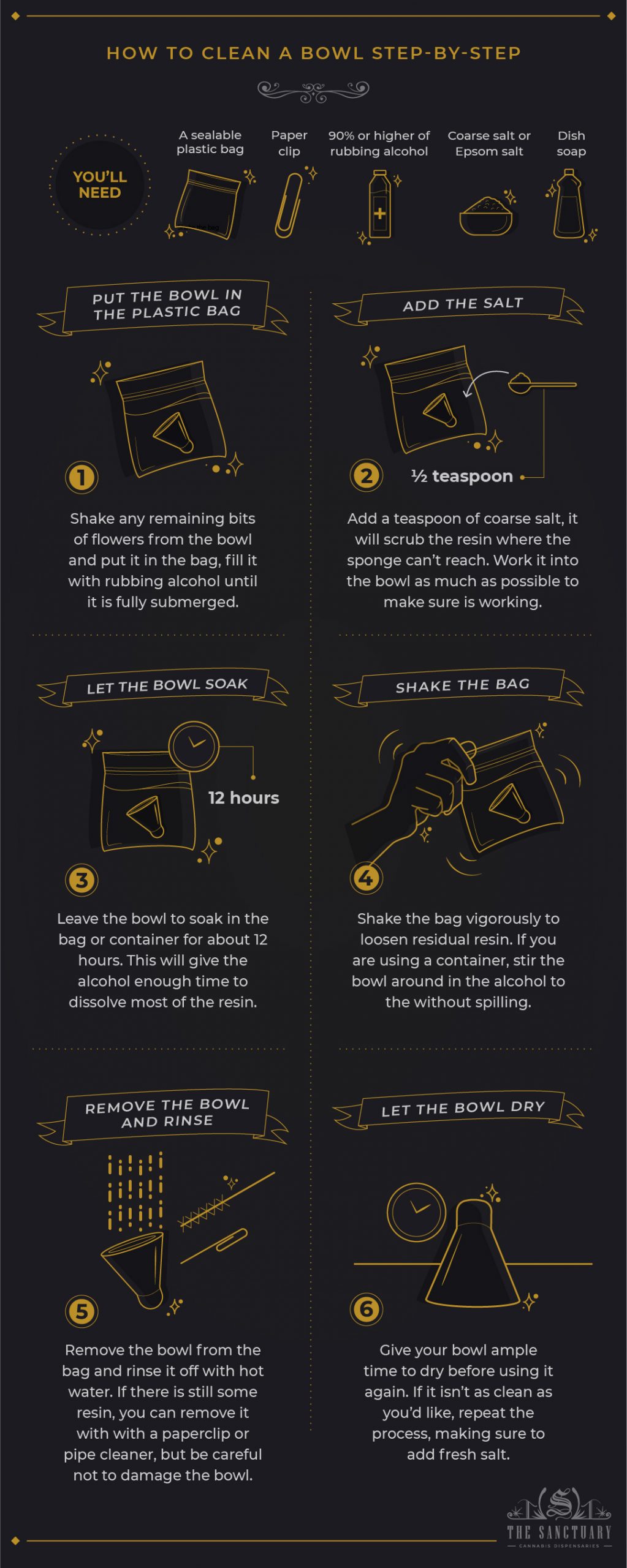Iftikhar Alam
Author
Reviewed by Cannabis Experts
Published on: April 6, 2021 | Updated on: September 1, 2024
Your bowl, bong, or pipe will become clogged with tar and resin after several uses, making it difficult and unpleasant to use. Fortunately, with a little time and some common home items, you can restore your smoking equipment to its original condition.
Why clean my bowl?
Knowing how to clean your bowl after several smoke sessions is critical. There are several reasons why you should maintain clean smoking gear at all times. Aesthetics are a key driving force, especially in the case of glass. What’s the purpose of spending money on a complex glass setup just to have it fill up with tar?
Cleaning your smoking equipment on a regular basis will also result in better-tasting hits. If you’ve ever grown your own weed, you know how much time and work it takes to produce high-quality bud. To cultivate a delicious terpene profile, you will need both talent and patience. Do not squander these delectable flavors by smoking from a filthy bowl.
The development of tar and resin in a dirty bowl will not only spoil the flavor but may also hurt your throat. Overall, smoking with cleaned equipment is a more pleasurable experience.
Is it bad to smoke out of a dirty pipe?
Because resin accumulation imparts a burned flavor to the smoke you inhale, smoking a filthy bowl is unpleasant. Filthy bowls provide some of the same health hazards as dirty bongs, which can retain hazardous chemicals in the bong water. Dirty bong water contains some of the same harmful compounds found within pipes, but pipes lack the capacity to develop microbes due to a lack of water.
There are at least 110 known chemicals that might settle onto the inside surface of your pipe, according to research released in 2020 that describes all known hazardous chemicals in cannabis smoke. While we don’t know what happens when those compounds are warmed, you might as well clear them out of your pipes on a regular basis.
Maintenance cleaning
Most of the time, a simple clean is all that is required. It’s mostly just a matter of clearing away ash and limiting resin build-up so that your bowl is ready to pack and puff anytime you want it. This type of fast, surface-level cleaning should be done every time you ash your bowl before packing it again.
Directly into a garbage can is the simplest method to accomplish this. Simply put your bowl over the garbage can and tap it lightly on your hand or the trash can’s side until the ash comes out. This is the easiest and most effective method for cleaning a bowl.
Give your bowl a quick scrape if a lot of ash is clinging to the resin. This is also a hint that you need a thorough cleaning. Clear away any ash that has collected in the bottom of the bowl and is blocking the opening. In this case, the easiest approach to clean a bowl is to block the carb with your finger.
Blow into the mouthpiece while the bowl is still upside down over the garbage bin. The air will be pushed into the bowl because the carb is blocked. As a result, the ash should be blown out of the path by the air.
How often should you clean your bowl?
The frequency with which you clean your smoking equipment should be determined by how often you use it. If you’re a frequent user, tar and resin will quickly accumulate. It will take longer for the residue to build up if you use a pipe or bong once a week. Leaving it unclean and unused, on the other hand, is not sanitary.
It is best if you clean your gear on a regular basis. After each smoking session, give your bong or pipe a brief washing to remove some of the tar and resin. When the accumulation becomes too much to bear and is stinking up the place, it’s time to clean your gear thoroughly.
It is simple to tell when a glass object needs to be cleaned. It is a different story with silicone and wooden components. Users of the latter can stay blissfully unaware until they inhale tarred smoke.
Different types of bowls
Different cleaning procedures are required for various materials. If you use the improper cleaning solution or procedure, you run the risk of harming your equipment. Here’s how to clean various materials:
- Glass and metal: On the delicate end of the range are glass bowls, bongs, and pipes. Although they appear to be more attractive, they are the most vulnerable to harm. Both alcohol and non-alcohol techniques can be used to efficiently clean glass. Boiling glass, on the other hand, should be avoided. Boiling metal pipes though is completely safe.
- Silicone: These are the most straightforward to clean. These components are heat and cold resistant and can withstand almost any situation. When cleaning silicone, you don’t have to be excessively cautious.
- Wood: Hot water can be handled by wooden pipes, but strong chemicals can harm them. Wooden pipes can be discolored by high-proof alcohol, which also leaves a residue. It is better to use gentler cleaning solutions, such as vinegar when cleaning a hardwood object.
What you will need
Gather the following things before you start cleaning your pipe:
- Plastic bag that can be sealed
- Paper clip or other thin metal implements
- Isopropyl alcohol in concentrations of 90 percent or higher (rubbing alcohol)
- Dish Soap
- Epsom salt or coarse salt
How to clean a bowl step-by-step
After you have gathered all of the following items, follow these procedures to clean out your bowl correctly:

Step 1: Fill a sealable plastic bag with alcohol and place the bowl inside.
Remove any leftover weed chunks from your bowl. Then gently place it in a sealable plastic bag and pour rubbing alcohol into it until the bowl is completely immersed. If you don’t have a baggie, a small sealable container like Tupperware would suffice. If you can’t shake the bowl in the cleaning solution like you can with a bag, you may need to soak it for longer.
Step 2: Add a teaspoon of salt to the mixture.
Add a teaspoon of coarse salt to the mixture. In locations where a genuine sponge or brush cannot reach, the salt will serve as a scrubber on the resin. To guarantee that the salt is completing its job of deep cleansing, work it as much as possible into the bowl. Cleaning bowls, bongs, and other water pipes are generally done with coarse sea salt, but kosher salt or Epsom salt would suffice.
Step 3: Soak the bowl.
Allow 12 hours for the bowl to soak in the bag or container. This will allow the alcohol to dissolve the majority of the resin.
Step 4: Give the bag a good shake.
Shake the bag briskly to release any remaining resin once the bowl has had time to soak. If you’re using a non-sealable container, skip this step. If this is the case, do your best not to spill the alcohol by stirring the bowl around in it.
Step 5: Rinse the bowl after removing it from the bag.
Remove your bowl from the bag once it has been soaked and shaken, and rinse it with hot water. If any sticky resin remains on your bowl, try scraping it off with a paperclip or pipe cleaner, but be cautious not to damage it. A cotton swab can also be used. Give the bowl a last rinse with warm or hot water after you’ve scraped it clean.
Step 6: Allow the bowl to air dry.
Allow plenty of time for your bowl to dry before using it again. If your bowl isn’t as clean as you’d like it to be, repeat the process, adding additional salt each time. The rubbing alcohol will have dissolved much of the salt from the previous round of cleaning.
Sources
Footnotes
- Graves BM, Johnson TJ, Nishida RT, Dias RP, Savareear B, Harynuk JJ, Kazemimanesh M, Olfert JS, Boies AM. Comprehensive characterization of mainstream marijuana and tobacco smoke. Scientific Reports. 2020;10(1):7160.
- Braunstein MM. Mindful Marijuana Smoking: Health Tips for Cannabis Smokers. Rowman & Littlefield; 2022.
- Raber JC, Elzinga S, Kaplan C. Understanding dabs: contamination concerns of cannabis concentrates and cannabinoid transfer during the act of dabbing. The Journal of toxicological sciences. 2015;40(6):797-803.
- Zhao T, Cheng KC, Ott WR, Wallace L, Hildemann LM. Characteristics of secondhand cannabis smoke from common smoking methods: Calibration factor, emission rate, and particle removal rate. Atmospheric Environment. 2020;242:117731.
References
- How to Properly Clean a Glass Weed Pipe. wikiHow. Accessed 4/9/2024.
- How to Clean a Bowl. How to Clean Things. Accessed 4/9/2024.
- How to clean a glass weed pipe to remove buildup and prevent bacteria growth. Business Insider. Accessed 4/9/2024.
The content provided on this blog is for informational purposes only and does not constitute medical, legal, or professional advice. Cannabis use is subject to local laws and regulations, which vary widely by jurisdiction. Always consult with a healthcare professional before starting any new treatment or altering an existing treatment regimen. The authors and publishers of this blog are not responsible for any actions taken based on the information provided herein. Use cannabis responsibly and in accordance with applicable laws. This blog is intended for adults aged 21 and over. The Sanctuary Dispensaries D186, D187.








